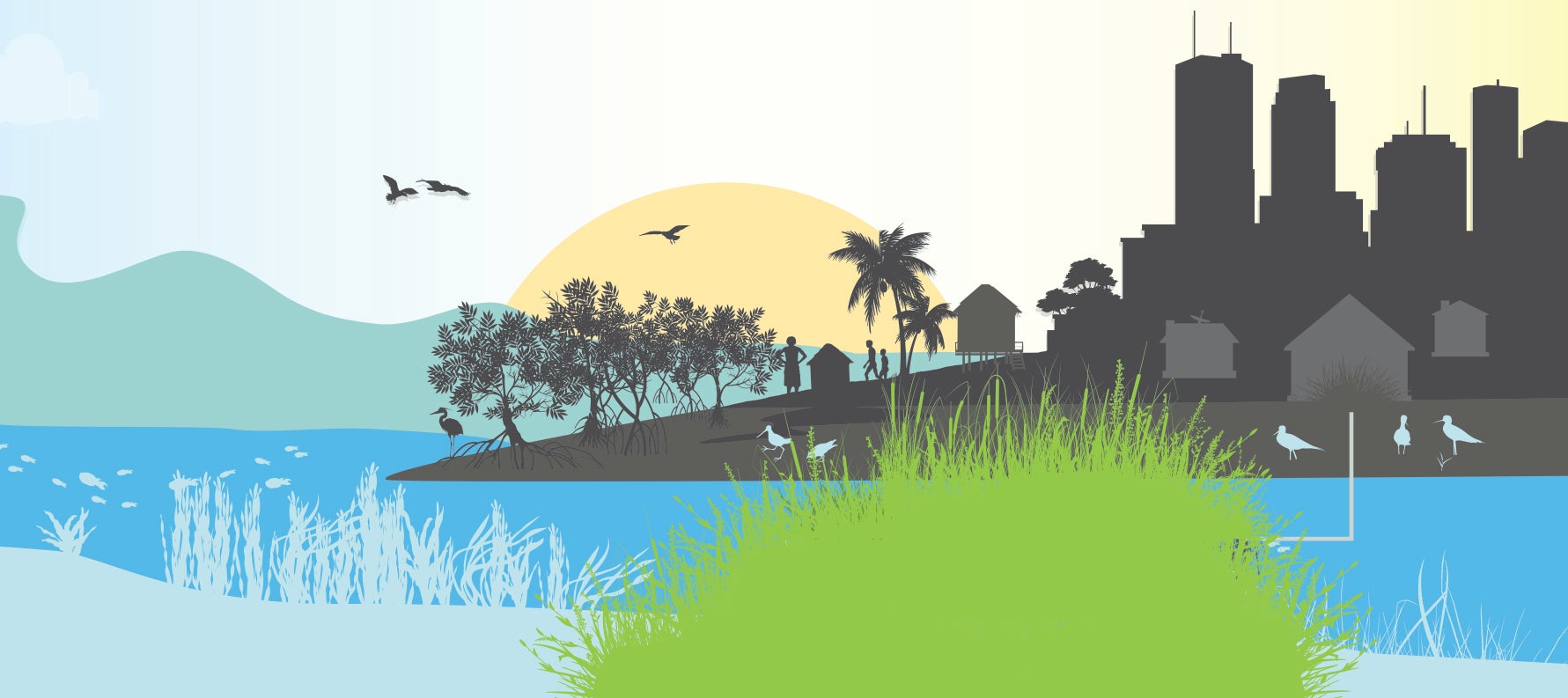
La página que intenta visitar sólo está disponible en inglés. ¡Disculpa!
The page you are about to visit is currently only available in English. Sorry!

Shorebird populations are experiencing large-scale declines across the globe. Along the coasts of the Americas, rapid development is destroying and degrading the mangroves, mudflats, and other wetlands that shorebirds depend on. Meanwhile, sea-level rise and extreme weather events are impairing habitat and warming ocean waters are decreasing populations of prey fish that birds eat.
Natural coastal ecosystems provide essential benefits to people by sheltering commercially harvested fish, protecting against coastal erosion and storm damage, and sequestering carbon. They also filter pollution and sediment and provide recreational and tourism opportunities.
Through our Coastal Resilience Strategy, Audubon and partners are working to restore or improve the management of 1 million hectares (2.5 million acres) of coastal bird habitat. Our innovative programs will achieve this goal by:
Mainstreaming nature-based and green infrastructure solutions into national and regional planning, policy, and implementation—to encourage smarter development and preserve the valuable services that intact coastal ecosystems provide
Quantifying and articulating the economic value of coastal bird habitat, in terms of reducing climate change risk and protecting public health
Convening coastal development, resilience, and biodiversity-conservation organizations and advocates around the common goals that unite them.

Chile’s coast and wetlands—and the benefits they provide to birds and communities—are threatened by land-use changes, degradation, and pollution. Audubon Americas projects in Chile aim to enhance shorebird conservation and empower local communities through nature-based solutions that include conservation action planning, coastal stewardship programs, and coastal wetland restoration.
For more than 15 years, Audubon has worked in Chile to protect migratory shorebirds and their habitats. Among our first priorities was the Chiloé Archipelago, where we have worked with our partner, the Centro de Estudio y Conservación del Patrimonio Natural (CECPAN) on an integrated approach to wildlife conservation.
In recent years our partnerships have expanded to include other local and regional NGOs as well as public-sector agencies such as the Chilean Ministry of Environment. Among our priority sites is Humedal-Marisma Rocuant Andalién, an Important Bird and Biodiversity Area (IBA) that is endangered by human activity. Audubon and our partner, Comité Nacional Pro Defensa de la Flora y Fauna (CODEFF), lead an initiative to mitigate threats to this important wetland. By fostering opportunities for sustainable livelihoods and implementing an innovative conservation action plan, we hope to eventually remove this coastal wetland from Chile’s list of endangered sites.
Audubon’s innovative Conserva Aves project is supporting Chile in its efforts to achieve its 30x30 goal and protect critical habitats for the survival of shorebird populations. We will also continue to support our partner CECPAN to promote municipal reserves and complementary tools to protect feeding and resting sites of the Hudsonian Godwit in the Chiloé Archipelago.
With 2,490 km (1,550 miles ) of coastline, Panama is a focal point for Audubon’s coastal resilience strategy. In Panama, Audubon Americas and Panama Audubon are working to save 202,340 hectares (500,000 acres) of the Panama Bay wetlands from unsustainable development. The Panama Bay mangroves and mudflats support migratory shorebirds from across the hemisphere, including a third of the global population of Western Sandpipers, a fifth of the world’s semipalmated Plovers, and dozens of other migratory bird species. To date, we have helped to develop the first conservation action plan for these wetlands.
Since 2009, we have been working to build a conservation-minded constituency through Aulas Verdes, the Panama Audubon Society’s signature environmental education program. Via field trips and weekly hands-on activities, schoolchildren experience nature and learn how local ecosystems support birds, fish, and other biodiversity found in and around the Bay of Panama. The National Audubon Society is proud to support this program, which has reached more than 20,000 students.
Recently, Audubon began collaborating with the Inter-American Development Bank and the Panama Audubon Society on a three-year, $2.3 million project that supports carbon capture, biodiversity, human well-being, and coastal resilience. The initiative aims to elevate the importance of Panama’s coastal mangrove ecosystems and related wetlands, the carbon they sequester, and the biodiversity and livelihoods they support. We will achieve this goal through a multi-pronged approach that includes:
Delivering robust science that establishes a blue-carbon baseline.
Establishing economic valuation of ecosystem services provided by mangroves and related wetlands.
Building knowledge, awareness, and engagement with key stakeholders to drive action that increases protection of these ecosystems.
Strengthening policies that promote mangrove conservation and reforestation.
The project will also support stronger climate-adaptation efforts, reduce deforestation and degradation, and build mechanisms that drive funding toward mangrove and coastal conservation.



Let us send you the latest in bird and conservation news.
